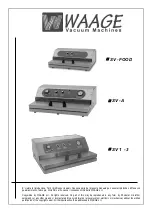
EN
66
IMPORTANT -
Do not leave the appliance connected to the power supply when
it is not in use.
EVACUATING A CONTAINER
Using the appliance, you may evacuate vacuum containers, designated for this pur-
pose: boxes and bottles with suitable lids and tops.
WARNING
– Only use the designated vacuum containers for vacuum packa-
ging. Unsuited containers could implode during evacuation or thereafter, with
splinters and splashes being hurled about. Always check the container and contai-
ner lid for proper condition before evacuation. There may be no cracks, distortions
or worn out seals. No parts of plastic containers may be brittle or friable. Handle
evacuated containers with special care to avoid damage and injuries due to
implosion.
Do not heat any evacuated and/or containers closed airtight.
Always
ventilate the container, before opening the lid.
NOTE
Always remove the container lid completely, before heating food within the vacu-
um container. Before heating, ensure that the container is sufficiently heat-resistant.
Do not heat vacuum containers directly on the range or in the oven. It is best to use
a bain-marie (pot with hot water). Microwave-resistant containers may be heated
in a microwave oven with the lid open.
NOTE
The designated vacuum hose may not fit to the lid of vacuum containers being sold
on the market but not recommended by the manufacturer. Before operation, check
whether your container is suited for usage with the appliance.
NOTE
To prevent germs from getting into your food, it is good advice to sterilize the con-
tainer and lid before filling in food. For this, you may rinse the container using hot
water (at least 80°C). However, ensure that the container will tolerate the high
temperature. After sterilization, do not wipe the container but leave it dry naturally
on a clean surface. When wiping with a cloth, germs could get onto the surfaces
of the container again.
1. Ensure that the container and container lid are undamaged, airtight and com-
pletely clean and dry.











































